As data centers around the world explore their options for increasing network speeds and bandwidth, 10G has been a traditional favorite, and 40G is not able to keep pace with the requirements. In this case, 100G network appears to be a preferable option to accelerate data flow for those bandwidth-hungry applications. QSFP28 transceiver module hence becomes the universal data center form factor for 100G optical transmission. This article will address the necessity of 100G network, while illustrating QSFP28 transceiver modules used in 100G transmission.
100G: The Optical Revolution in Data Centers
The 100G adoption rate in optical landscape is consistently on the rise for the past few years. It is predicted that over half of the data center optical transceiver transmission will make the shift to 100G. The traditional 10G or even 40G may not be enough considering the explosion of data, therefore, 100G is going to become the new standard, and it has the following advantages.
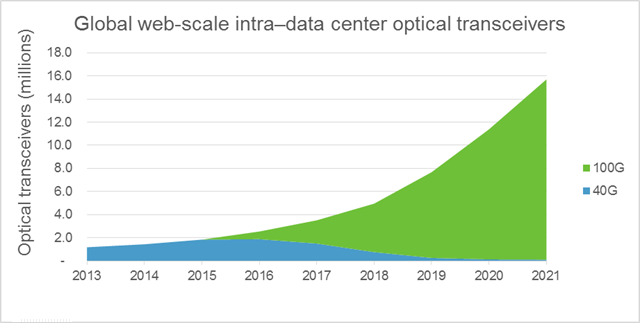
Cost Efficiency—100G now delivers a compelling price point, offering far greater capacity increases for the cost. And it still future-proofing the network with unsurpassed bandwidth.
Proactive Scale—100G offers the expansion and scalability to support the reliability, manageability and flexibility demanded of modern networks while preparing data centers for future bandwidth and speed requirements.
Speed and Capacity—10GG optical transport will not be enough for data intensive industries. Thus 100G is specifically designed to transport enormous amounts of data with ultra-low latency.
Flexibility—100G will be the preferred technology across long-haul networks. 100G networking can be customized, optimized, and easily expanded to allow for changes in the future.
Cost Decrease—The market transition to 100GE is now in full force. The growth in 100G deployments will undoubtedly drive down the cost of 100G transceiver modules.
100G QSFP28 Transceiver Unravel
QSFP28 transceiver generally has the exact same footprint and faceplate density as 40G QSFP+ . Just as the 40G QSFP+ is implemented using four 10Gbps lanes, the 100G QSFP28 transceiver is implemented with four 25-Gbps lanes. With an upgrade electrical interface, QSFP28 transceiver is capable of supporting signal up to 28Gbps signals. Though QSFP28 transceiver keeps all of the physical dimensions of its predecessors, it surpasses them with the strong ability to increase density, decrease power consumption, and decrease price per bit. The Following are some QSFP28 transceivers for different applications.
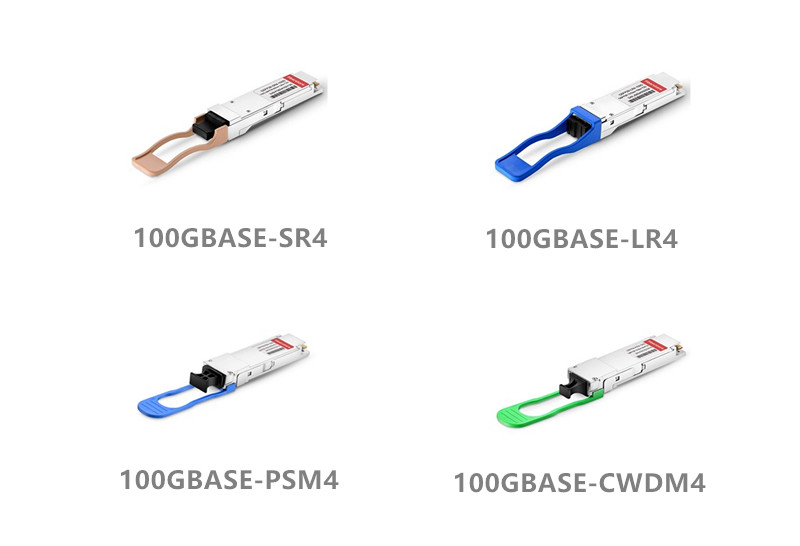
QSFP28 100GBASE-SR4
100G QSFP28-SR4 came out firstly to support short distance transmission via multimode fiber. This transceiver module can support 100G transmission up to 70m on OM3 MMF and 100m on OM4 MMF. With MTP interface, the 100G QSFP28-SR4 module enables 4×25G dual way transmission over 8 fibers.
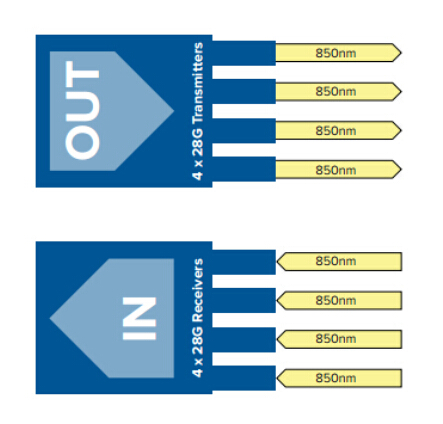
QSFP28 100GBASE-LR4
100G QSFP28-LR4 is specifically designed for long distance transmission. The module utilizes WDM technology for 4×25G data transmission, and these four 25G optical signals are transmitted over four different wavelengths. With a duplex LC interface, the 100G QSFP28-LR4 module enables 100G dual-way transmission up to 10 km over single-mode fiber.
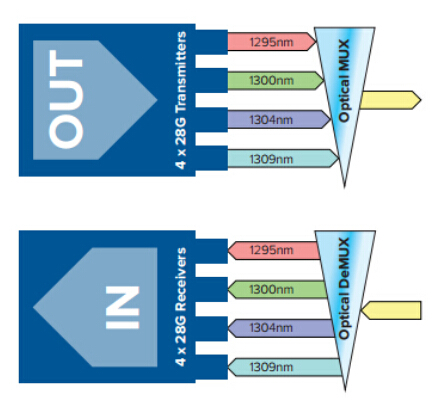
QSFP28 100GBAS-PSM4
PSM4 uses four parallel fibers (lanes) operating in each direction, with each lane carrying a 25G optical transmission. It sends the signal down to eight-fiber cable with an MTP interface. The operating distance of 100G QSFP28-PSM4 is limited to 500 m.
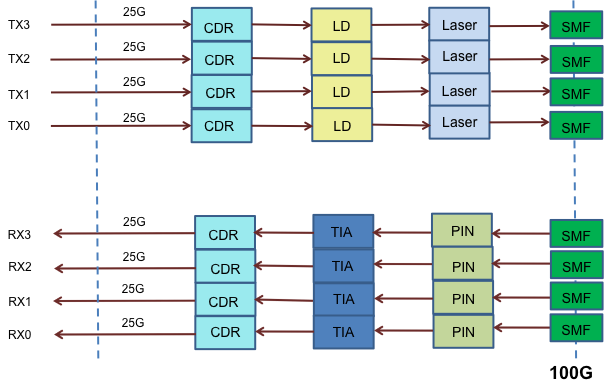
QSFP28 100GBASE-DWDM4
DWDM4 uses WDM technology—an optical multiplexer and de-multiplexer to reduce the number of fibers to 2. It can operate on single-mode fiber up to 2 km over duplex LC interface. Compared with QSFP28-LR4, it has shorter transmission distance and lower cost.
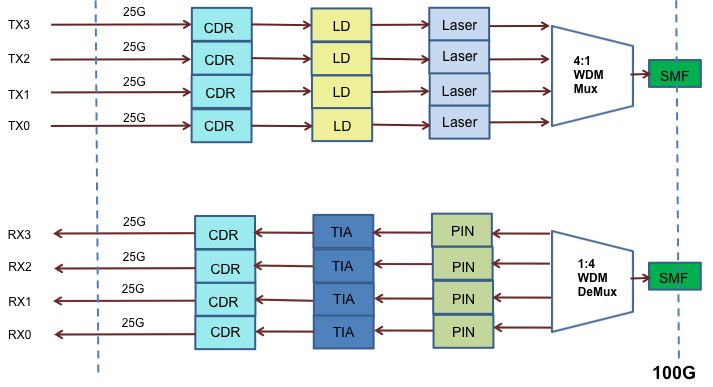
100G QSFP28 Cables
In addition to the QSFP28 transceiver modules mentioned above, cables can also be deployed in 100G transmission. The cables can be either direct-attach copper cables (DACs), or active optical cables (AOCs). QSFP28 DACs offer the lowest cost but are limited in reach to about 3 m. They are typically used within the racks of the data center, or as chassis-to-chassis interconnect in large switch and routers. QSFP28 AOCs are much lighter and offer longer reach up to 100 m and more.
Frequently Asked Questions About QSFP28 Transceiver
What Is the Difference Between QSFP28 Transceiver and QSFP+?
These two have the same size form factor and the number of ports, however the lane speeds of QSFP28 transceiver are increased from 10 Gbps to 25 Gbps. The increase in density is even more dramatic when compared to other 100Gbps form factors: 450% versus the CFP2.
How Many QSFP28 Transceiver Moduels Can Fit into One Switch?
With QSFP28 transceiver, a one rack-unit (RU) switch can accommodate up to 36 QSFP28 ports. While many more varieties of transceivers and cables (DACs and AOCs) can plug into these ports.
Conclusion
100G QSFP28 transceiver offers direct compatibility with your existing switches and routers, and it facilitates the process of scaling to 100G networks with the simplicity as 10G networks. With higher port density, lower power consumption and lower cost, QSFP28 transceiver is an ideal alternative for large scale data centers, as well as future network expansions. All the QSFP28 transceiver modules presented in this article are available at FS.COM. For more details, please visit www.fs.com.

No comments:
Post a Comment